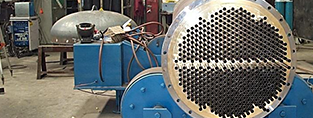
- (03) 5909 8218
- enquiry@fusionweld.com.au
The Importance of Pressure Vessel Safety, Inspection and Maintenance
August 19, 2015

Inspection and maintenance routines are an essential part of engineering. There's no exception to this rule. Even maintenance-free machines, the equipment recommended by diligent design engineers, are subject to deterioration. An inspection strategy is thus a genuine imperative if expensive gear is to stay in service. But more than this, much of the equipment in service today is defined by incredibly hazardous attributes. Pressure vessels, in particular, contain toxic chemicals and pressurized gases. The pressures we're referring to are so intense that fluids within the vessel undergo a state change. Gases become liquids and "flash" back to a gas when placed in a condensate cycle. Imagine this as a refrigeration mechanism but one that's been scaled to manage a stream of cryonically processed liquid nitrogen.
If the worst were to happen, a pressurized vessel were to leak or deteriorate to the point that contents could escape into the air, then a liquid nitrogen spill would cause damage, but this is an inert substance, meaning only the extremely cold temperature would present an environmental risk. Even so, lives would be lost in this hypothetical scenario due to the asphyxiating effects of the liquid as it expanded and regained its gaseous form. And this is only an example of a minor leak. Without a carefully regimented inspection strategy, vessels would leak flammable liquids or toxic acids, fluids that would flash and transition into a dangerous cloud of poisonous fumes.
As the dangers of this catastrophic scenario are known intimately by manufacturing engineers and installers alike, manufacturing science is both morally and lawfully compelled to do everything in its power to avoid such dangers. This is why maintenance is designed to partner with an inspection philosophy. Under the AS/NZS 3788 mandatory guidelines, an in-service inspection evaluates each pressure vessel in an installation for operational viability. A scheduled preventative maintenance plan reinforces the inspection mandate by using a structured approach to deterioration issues. In other words, it's not enough to spot a broken fastener or a worn seal and record the safety concern for someone else to fix on their next shift. The maintenance plan prevents safety issues by replacing potential safety weak points in a timely manner as set by the incorporated plan. Worn or apparently undamaged, these parts will be replaced.
Every pressure vessel and its associated framework is guarded by safety measures, by safety valves and redundancy systems. Lightning conductors and grounding networks accent the metal outline of the frame. Protective gear is worn, ladders are in place, and safety rails are installed everywhere. But these are active protective assets. The in-service inspection plan takes this methodical approach to the next level by attending to faults before they become major, safety-compromising problems, issues that simply can't be afforded in a pressurized environment where dangerous chemicals are contained inside welded vessels.
Contact Details
Fusion - Weld Engineering Pty Ltd
ABN 98 068 987619
1865 Frankston Flinders Road,
Hastings, VIC 3915
Ph: (03) 5909 8218
Optimized by NetwizardSEO.com.au
Recent Posts
- Compressed Hydrogen Storage Vessels: Material Selection, Design & Australian Standards
- Welding QA/QC in Oil & Gas Pressure Vessel Fabrication – Ensuring Code Compliance
- AS1210 vs ASME VIII Pressure Vessel Code: Key Differences for Australian Projects
- Mitigating Hydrogen-Induced Cracking in Pressure Vessels: Engineering and Material Strategies
- Storage Tank Solutions Australia: Field-Erected, Prefabricated & Self-Bunded Explained
- Reducing Environmental Risks: Self-Bunded Tanks in Australian Oil & Gas Operations
- Precision in Production: How Pressure Vessels Are Manufactured for Industrial Safety
- Shell & Tube Heat Exchangers: Improve Thermal Control & Energy Recovery in Petrochemical & Pharmaceutical Plants
- In-Service Inspection for Compressed Air Receivers for Power Plant Shutdown Prevention
- Power Plant Pipe Spooling Fabrication – Get Rapid, Code-Compliant Spools Ready for Installation
- Field Erected Tanks: Safe, Reliable On-Site Fuel Storage Solutions in Australia
- Custom Pressure Vessel Fabrication for Flammable Gases
Posts 2025
- Compressed Hydrogen Storage Vessels: Material Selection, Design & Australian Standards
- Welding QA/QC in Oil & Gas Pressure Vessel Fabrication – Ensuring Code Compliance
- View all articles…
Posts 2024
- Large Process Vessels: Optimising the Design for Maximum Efficiency [2025]
- Pressure Equipment Management System Installation: Detect Equipment Faults Early
- View all articles…
Posts 2023
- Pressure Piping System Inspection: A Gift of Safety for the Holidays
- Deaerator Inspections by Fusion-Weld Engineering and How They Reduce System Downtime
- View all articles…
Posts 2022
- How Fusion Weld Keeps Up With AS-NZS ISO 9001:2008 Standard
- Boiler Equipment Safety Inspection During the Summer Season
- View all articles…
Posts 2021
- Avoid These Factors and Practices that Contribute to Sealing Damage in Pressure Vessels
- Do's And Don'ts Of Industrial Boiler Inspection And Maintenance From Fusion-Weld
- View all articles…
Posts 2020
- What are the Risks and Hazards Involved in Pressure Vessel Equipment?
- How to Know if Your Pressure Equipment Needs Repair or Replacement?
- View all articles…
Posts 2019
- Factors that Contribute to Pressure Vessel Failure
- Pressure Vessel Regulations in Australia: What are the Mandatory Requirements?
- View all articles…
Posts 2018
- Pros and Cons of Spherical vs. Cylindrical Pressure Vessels
- What are the Different Hazard Levels in Pressure Vessels?
- View all articles…
Posts 2017
- Transportable Pressure Vessels: The Importance of Inspection and Safety Checks
- Fracture Mechanics and Stress Analysis of Cracks in Pressure Vessels
- View all articles…
Posts 2016
Posts 2015
- What Are Deaerators & Feedwater Vessels?
- Precautions and Safety for Compressed Air Receiver Vessels
- View all articles…
Posts 2014
- Demonstrating In-process Inspection Procedures
- Static Grounding Practices and Standards
- View all articles…